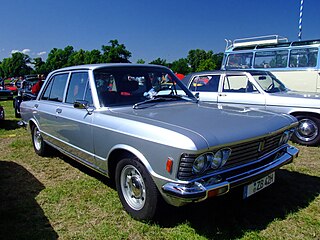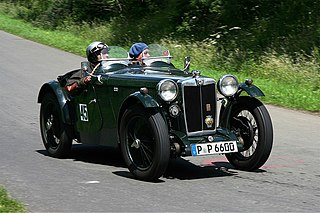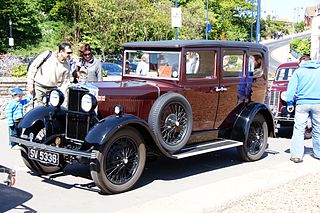
The Fiat 130 is a large six cylinder executive car produced by Italian car manufacturer Fiat from 1969 to 1977. It was available as a 4-door saloon and as a 2-door coupé.

The Lancia Fulvia is an automobile produced by Lancia between 1963 and 1976. Named after Via Fulvia, the Roman road leading from Tortona to Turin, it was introduced at the Geneva Motor Show in 1963 and manufactured in three variants: Berlina 4-door saloon, 2-door Coupé, and Sport, an alternative fastback coupé designed and built by Zagato on the Coupé floorpan.

The MG T-Type is a series of body-on-frame open two-seater sports cars that were produced by MG from 1936 to 1955. The series included the MG TA, MG TB, MG TC, MG TD, and MG TF Midget models. The last of these models, the TF, was replaced by the MGA. Although the design was similar to contemporary cars of the 1930s, it came to be considered outdated by the 1950s.

The MG P-type is a sports car that was produced by MG from 1934 to 1936. This 2-door sports car used an updated version of the Wolseley Motors-designed and made overhead camshaft, crossflow engine, used in the 1928 Morris Minor and previously fitted in the J-type Midget of 1932 to 1934, driving the rear wheels through a four-speed non-synchromesh gearbox. The chassis was a strengthened and slightly longer version of that used in the J-type with suspension by half-elliptic springs all round with rigid front and rear axles. Steering was initially by a Marles Weller and later a Bishop Cam system. The two-seat car had a wheelbase of 87 inches (2210 mm) and a track of 42 in (1,100 mm). Most cars were open two-seaters, but streamlined Airline coupé bodies were also made. The P-type was also available as a four-seater, a car that suffered from a lack of power and poor rear ground clearance. Whereas J, K and L-type MGs differentiated between versions with the use of numbers, with 1 indicating a four-seater and 2 a two-seater, this was not the case with the P-type, and there is no clue to the type in the name.
Morris Cowley was a name given to various cars produced by Morris from 1915 to 1958.

The MG F-type Magna is a six-cylinder-engined car that was produced by MG from October 1931 to 1932. It was also known as the 12/70.
SS Cars was a British manufacturer of sports saloon cars from 1934 until wartime 1940, and from March 1935 of a limited number of open 2-seater sports cars. From September 1935, their new models displayed a new name: SS Jaguar. By then, its business, which was founded in 1922, was run by and largely owned by William Lyons. Lyons had been partner with 1922 co-founder William Walmsley until Walmsley sold his shareholding in January 1935.
The MG K-type Magnette is a motor car produced in the United Kingdom by MG from October 1932 to 1934.

The MG L-type is a sports car that was produced by the MG Car company in 1933 and 1934.

The Morris Ten announced 1 September 1932 is a medium-sized car introduced for 1933 as the company's offering in the important 10 hp sector of the British market. It continued through a series of variants until October 1948 when along with Morris's Twelve and Fourteen it was replaced by the 13.5 hp Morris Oxford MO.

The Vauxhall Wyvern is a medium-sized family car introduced by Vauxhall in 1948 as a successor to the Vauxhall 12. The name comes from the mythical beast the wyvern, and may be due to a misidentification of the heraldic griffin on the Vauxhall badge.

The Sunbeam-Talbot 90 is an automobile which was produced and built by Sunbeam-Talbot from 1948 to 1954 and continued as the Sunbeam Mk III from 1954 to 1957.

The Bedford HA was a car derived van introduced in 1964 by Bedford, based on the Vauxhall Viva (HA) family car. It was also known as the Bedford Beagle in estate form and Bedford Roma in small campervan form. The Beagle was an officially sanctioned conversion based on the 8 cwt van, carried out by Martin Walter of Folkestone, Kent. The Beagle received rear side windows and a fold-down rear seat; leaving 28 inches (710 mm) of luggage space with the seat in use.

The Rover 12 was a name given to several medium-sized family cars from the British Rover car company between 1905 and 1948.

The Vauxhall 30–98 is a car manufactured by Vauxhall at Luton, Bedfordshire from 1913 to 1927. In its day, its best-known configuration was the Vauxhall Velox standard 4-seater with open tourer body. Vauxhall's own description was the 30–98 hp Vauxhall-Velox sporting car. The 30–98 is also known to enthusiasts by Vauxhall's chassis code E.

The Morris Major is an automobile produced by Morris Motors in the United Kingdom from late 1930 until 1933. It was described by commentators as a Morris Oxford Six with a coachbuilt saloon body. 4025 examples of the 1931 model were produced followed by 14,469 of the 1932-33 model.

The Vauxhall 14-6 is an automobile produced by Vauxhall in the United Kingdom from 1939 until 1948.

The Vauxhall 20-60 is a four or five-seater saloon, limousine, tourer or coupé-cabriolet manufactured by Vauxhall of Luton. It was announced on 28 September 1927 with a six-cylinder engine and a four-speed gearbox. A cautious move downmarket. "The first time any six-cylinder Vauxhall has been sold under £1000!" "British & Vauxhall". The initial 2.7-litre engine was enlarged to 3-litres after twelve months.

The Singer Nine is a car which was produced by Singer Motors Limited from February 1933 to 1937, and then again from 1939 until 1949 as a Roadster only. It was offered as a new economy model, replacing the earlier Singer Junior series. The "Nine" engine was briefly fitted inside the body of the earlier Junior as a solution to production problems in 1932. The hybrids are known as the "Junior Nine" and are recognisable by the cursive "Nine" badge adorning the radiator stone-guard.

The Vauxhall Big 6 is a name given to a series of automobiles which was produced by Vauxhall in the United Kingdom from 1934 to 1940. Rolling chassis were also bodied in Australia.


















